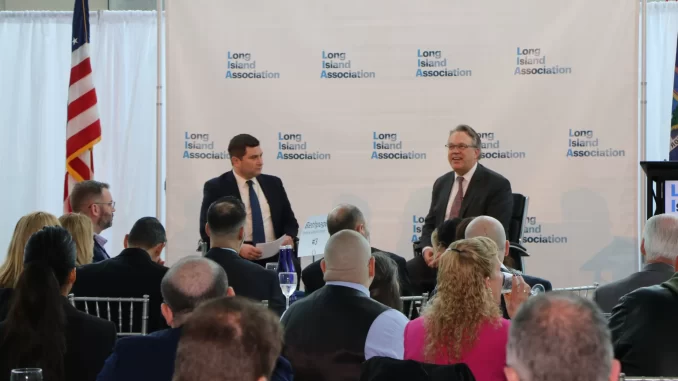
Says His Main Focus Is Controlling Inflation
By Hank Russell
Attendees converged at the Cradle of Aviation Museum in Garden City on February 28 as The Long Island Association hosted a discussion by John Williams, the president and CEO of the New York Federal Reserve. During the presentation, Williams shared his thoughts on the economic conditions of Long Island and the future of the Island’s economy.
Before joining the New York Fed in 2018, Mr. Williams was the President and CEO of the San Francisco Federal Reserve, which he first joined in 2002 and subsequently served as research director. He began his career as an economist at the Federal Reserve’s Board of Governors, and he has also served in roles at the White House Council of Economic Advisers and Stanford University’s Graduate School of Business.
“As business leaders, you know — all too well — the impact that the pandemic had on our communities and our economy,” Williams said, adding that Long Island’s economy “mirrors [that of] New York City’s.”
Williams pointed out that Long Island felt a greater impact from the pandemic than the rest of the nation. But, since then, the economy has turned around, thanks to the strong number of jobs on record that exceeded that before Covid occurred. In addition, global supply chains, which came to a crashing halt during Covid, have returned or nearly returned to the same pre-pandemic levels, Williams said.
When the pandemic was over, the labor market “became red-hot,” Williams said. “Workers exceeded supply … now, the labor market has been showing signs of coming back to normal.”
Despite the good news, Williams cited two factors that are tightening up the labor market: job openings and wage growth. “Job vacancies reached all-time highs during the red-hot labor market in 2022,” he explained. “They’ve been trending lower since, but are still higher than pre-pandemic norms. And while we have seen wage growth come down from pandemic-level peaks, they remain above pre-Covid peaks.”
“The economy grew faster than anyone expected a year ago,” he said, citing increases in participation in the labor force, which stayed strong as the unemployment rate remained below 4%.
However, Williams said he foresees a slowdown this year, including an anemic 1.5% increase in the gross domestic product (GDP) and the unemployment rate creeping up to 4%.
Williams soon shifted the topic of the discussion to the Fed’s main focus: inflation. He said he and his Federal Reserve Council members were working hard to keep the rate of inflation down to 2%. He emphasized that the Fed does not implement economic policy, but rather determine rate cuts or increases, depending on economic activity.
Forty years ago, inflation peaked at 7%, according to Williams, it has since fallen precipitously to 2.5%.
Before the pandemic, inflation was at 1.8%, which was below the Fed’s target rate of 2%, Williams said. But it started to increase as a result of the pandemic and the escalation of the war in the Ukraine. In June 2022, inflation peaked at 5.5%, but, over time, inflation trended downward, falling to 2.2% in December 2023.
The current decline in the inflation rate, Williams noted, can be attributed to the decrease in the supply-and-demand ratio in the U.S. and worldwide and the resolution of the supply chain bottlenecks that hindered the economy.
“Like traveling to the moon and back, inflation shot up and came back down,” he said. “Like with the Apollo missions, it’s the safe trip home that’s essential.”
Williams predicted an inflation rate of 2.25% for this year and that the Fed would not achieve their target rate until 2025. “There will be some bumps along the way,” he said. “We’re not there yet.”

